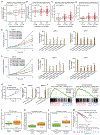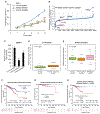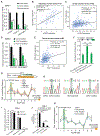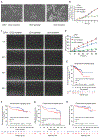Biology and Clinical Implications of the 19q13 Aggressive Prostate Cancer Susceptibility Locus
- PMID: 30033361
- PMCID: PMC6091222
- DOI: 10.1016/j.cell.2018.06.003
Biology and Clinical Implications of the 19q13 Aggressive Prostate Cancer Susceptibility Locus
Abstract
Genome-wide association studies (GWAS) have identified rs11672691 at 19q13 associated with aggressive prostate cancer (PCa). Here, we independently confirmed the finding in a cohort of 2,738 PCa patients and discovered the biological mechanism underlying this association. We found an association of the aggressive PCa-associated allele G of rs11672691 with elevated transcript levels of two biologically plausible candidate genes, PCAT19 and CEACAM21, implicated in PCa cell growth and tumor progression. Mechanistically, rs11672691 resides in an enhancer element and alters the binding site of HOXA2, a novel oncogenic transcription factor with prognostic potential in PCa. Remarkably, CRISPR/Cas9-mediated single-nucleotide editing showed the direct effect of rs11672691 on PCAT19 and CEACAM21 expression and PCa cellular aggressive phenotype. Clinical data demonstrated synergistic effects of rs11672691 genotype and PCAT19/CEACAM21 gene expression on PCa prognosis. These results provide a plausible mechanism for rs11672691 associated with aggressive PCa and thus lay the ground work for translating this finding to the clinic.
Keywords: CEACAM21; GWAS; HOXA2; PCAT19; aggressive prostate cancer; allele-specific DNA-binding of transcription factor; eQTL; risk stratification; rs11672691; single cell CRISPR/Cas9-mediated editing.
Copyright © 2018 Elsevier Inc. All rights reserved.
Figures






Comment in
-
Changing the Guard at a Prostate Cancer SNP.Cell. 2018 Jul 26;174(3):501-502. doi: 10.1016/j.cell.2018.07.014. Cell. 2018. PMID: 30053422
-
Mechanistic insights into a non-coding risk SNP.Nat Rev Urol. 2018 Nov;15(11):655. doi: 10.1038/s41585-018-0079-9. Nat Rev Urol. 2018. PMID: 30135604 No abstract available.
References
-
- Alkelai A, Lupoli S, Greenbaum L, Kohn Y, Kanyas-Sarner K, Ben-Asher E, Lancet D, Macciardi F, and Lerer B (2012). DOCK4 and CEACAM21 as novel schizophrenia candidate genes in the Jewish population. Int. J. Neuropsychopharmacol 15, 459–469. - PubMed
-
- Amin Al Olama A, Kote-Jarai Z, Schumacher FR, Wiklund F, Berndt SI, Benlloch S, Giles GG, Severi G, Neal DE, Hamdy FC, et al. (2013). A meta-analysis of genome-wide association studies to identify prostate cancer susceptibility loci associated with aggressive and non-aggressive disease. Hum. Mol. Genet 22, 408–415. - PMC - PubMed
-
- Arredouani MS, Lu B, Bhasin M, Eljanne M, Yue W, Mosquera JM, Bubley GJ, Li V, Rubin MA, Libermann TA, et al. (2009). Identification of the transcription factor single-minded homologue 2 as a potential biomarker and immunotherapy target in prostate cancer. Clin. Cancer Res 15, 5794–5802. - PMC - PubMed
Publication types
MeSH terms
Substances
Grants and funding
LinkOut - more resources
Full Text Sources
Other Literature Sources
Medical
Research Materials

